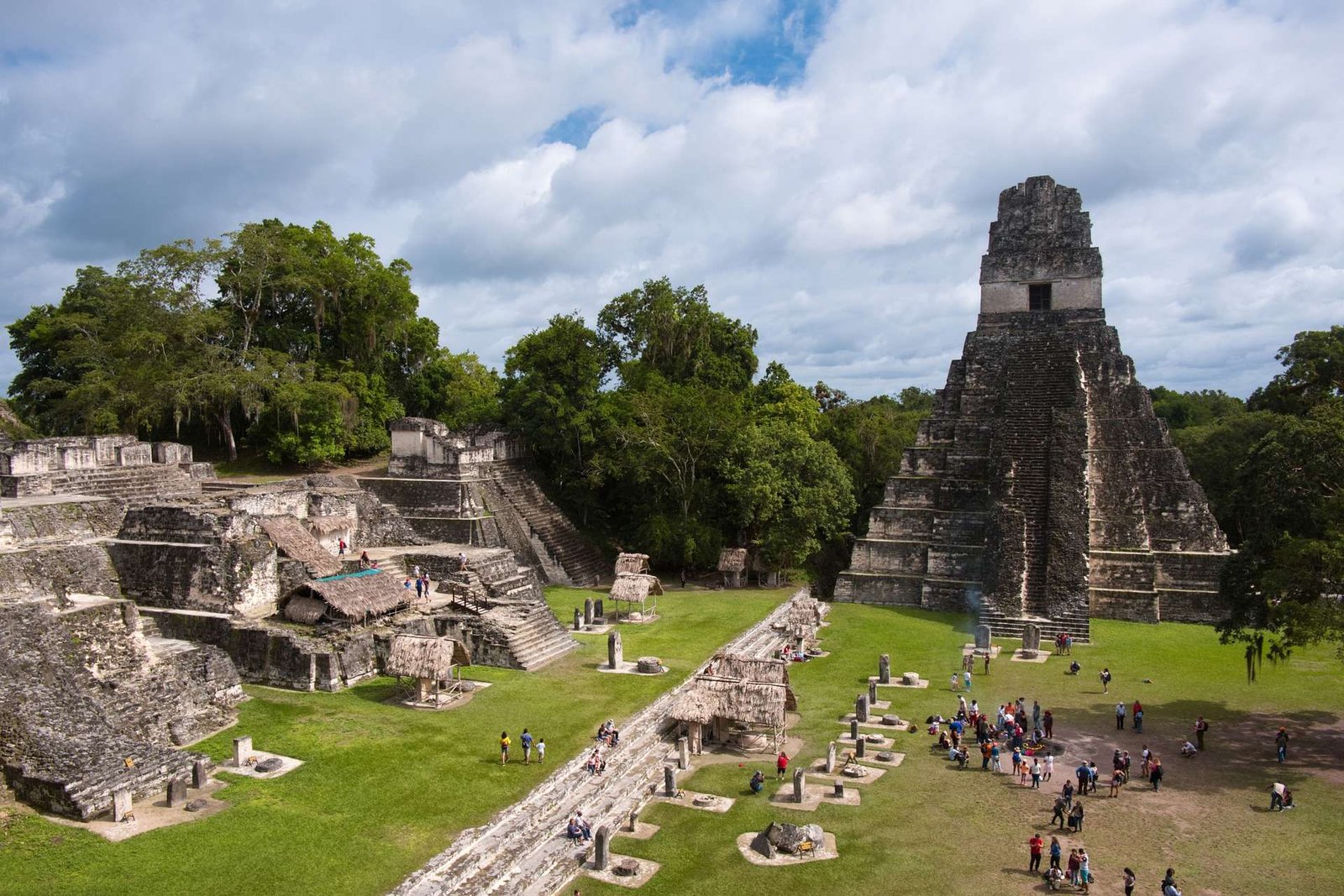Are you fascinated by ancient civilizations and the mysteries of the past? If so, you’ll be delighted to discover some of the best destinations for ancient history and archaeological sites around the world. These remarkable places offer a glimpse into lost civilizations and provide a deeper understanding of human history.
From the towering pyramids of Egypt to the ancient ruins of Rome, each destination on this list holds significant historical and cultural importance. As you explore these remarkable sites, you’ll walk in the footsteps of past civilizations and witness the architectural marvels they left behind.
So, grab your explorer’s hat and join us as we embark on a journey through time. Let’s dive into the top destinations for ancient history and archaeological sites that will leave you awe-struck.
Key Takeaways:
- Discover the best destinations for ancient history and archaeological sites
- Uncover the mysteries of past civilizations and their cultures
- Explore iconic landmarks such as Stonehenge and the Great Pyramids
- Immerse yourself in the rich history and cultural heritage of these sites
- Experience the wonder of ancient architecture and engineering marvels
Stonehenge
Embark on an unforgettable journey through time with a visit to Stonehenge, one of the most remarkable archaeological sites in the world. Located in the United Kingdom, this prehistoric monument captivates visitors with its massive stone circle and mysterious origins.
The towering stones, believed to have been arranged by Neolithic and Bronze Age civilizations, create an awe-inspiring sight. Whether used as a burial ground or a sacred site for ritualistic ceremonies, Stonehenge’s purpose continues to intrigue historians and archaeologists.
As you explore Stonehenge, immerse yourself in the ancient world and ponder the enigmatic stories that these stones hold. Witness the convergence of past and present and gain a deeper understanding of humanity’s rich cultural heritage.
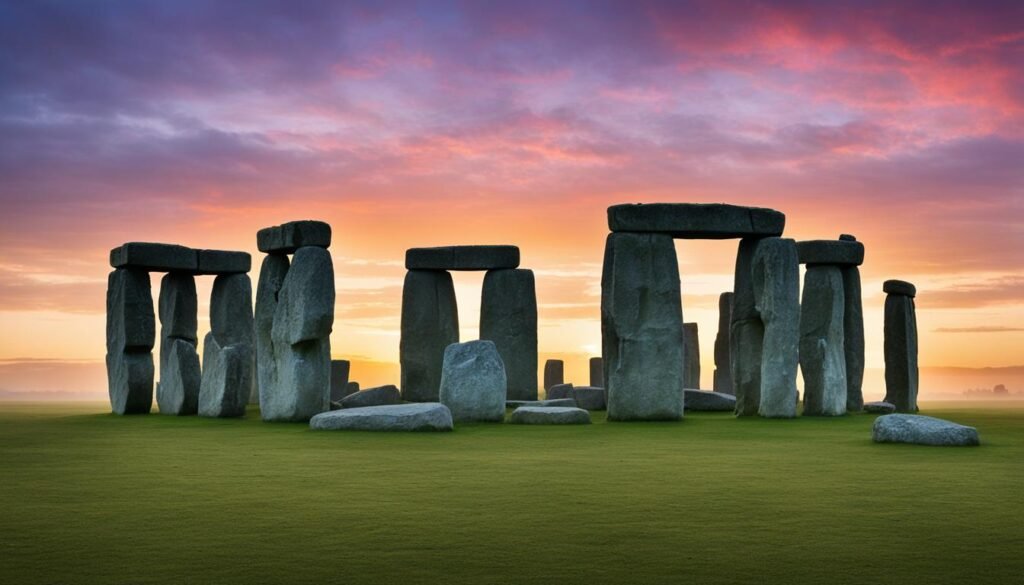
Unraveling the Mystery
“Stonehenge has stood the test of time, leaving us with more questions than answers. Its significance in ancient history cannot be overstated.” – Archaeologist Dr. Emily Roberts
A UNESCO World Heritage Site, Stonehenge is not only a testament to human ingenuity but also a symbol of our enduring fascination with the past. Travelers seeking ancient history vacations and historical ruins tours will find Stonehenge to be an essential destination.
Planning Your Visit
To make the most of your Stonehenge experience, consider these practical tips:
- Book your tickets in advance to secure your preferred time slot.
- Allow ample time for exploration and contemplation.
- Dress comfortably and consider the weather.
- Join a guided tour for expert insights and storytelling.
Stonehenge Visitor Information
| Opening Hours | Admission Fee | Tour Options |
|---|---|---|
| Open daily, year-round | Adults: $20 Children (under 12): Free |
Guided tours available Self-guided audio tours |
Embark on an unforgettable journey through time at Stonehenge. Delve into the ancient mysteries that encompass this enigmatic monument, and let its powerful presence transport you to a bygone era.
The Great Wall of China
The Great Wall of China is an architectural marvel that spans over 13,000 miles, making it the world’s largest military structure. Built by Emperor Qin Shi Huang during the Qin Dynasty, this ancient wonder was designed to protect China from invasions by nomadic tribes. The wall is a testament to the engineering skills and strategic vision of the ancient Chinese civilization.
Constructed using a mix of earth and stone, the Great Wall features watchtowers strategically placed along its length. These guard towers served as lookout points and communication centers, allowing the defenders to detect and respond to potential threats. Today, the Great Wall is not only a symbol of China’s rich history but also a popular tourist attraction for travelers interested in exploring ancient civilizations.

Key Features of the Great Wall:
- Spanning over 13,000 miles, making it the longest man-made structure in the world.
- Made of earth and stone, showcasing the ingenuity of ancient Chinese engineering.
- Constructed to defend against invasions from nomadic tribes.
- Features strategically placed guard towers for surveillance and defense.
- A UNESCO World Heritage Site, recognized for its historical and cultural significance.
“The Great Wall of China is a testament to the remarkable achievements of ancient civilizations. It stands as a physical symbol of the immense effort and strategic foresight put forth by the ancient Chinese people.”
Visiting the Great Wall of China offers a glimpse into the ancient world and provides a unique opportunity to immerse oneself in the rich history of this fascinating civilization. As you explore this monumental structure, you can’t help but marvel at the remarkable engineering and imagine the countless stories that have unfolded along its storied path. The Great Wall of China is truly a must-see destination for anyone passionate about ancient history and archeological sites.
Chichén Itzá
Chichén Itzá, located in Mexico, was once a thriving Mayan city. This ancient archaeological site is a must-visit destination for anyone interested in exploring the wonders of ancient history. One of the most notable features of Chichén Itzá is the step pyramid called El Castillo, which stands tall and majestic.
This pyramid, dedicated to the god Kukulkán, showcases the incredible architectural and engineering skills of the Mayan civilization. But what makes El Castillo truly remarkable is its ability to create a mesmerizing shadow illusion during the equinoxes. As the sun casts its rays, a serpent-like shadow slithers down the pyramid’s steps, leaving visitors in awe of this ancient marvel.
As you explore Chichén Itzá, you’ll also encounter other fascinating structures, such as the Temple of the Warriors and the Great Ball Court. These structures reflect the unique cultural and religious practices of the Mayans and offer a glimpse into their sophisticated society.
“Chichén Itzá is a testament to the ingenuity and creativity of the Mayan civilization. It’s awe-inspiring to witness the complex architecture and symbolic significance behind each structure.”
Designated as a UNESCO World Heritage Site, Chichén Itzá is not only a remarkable archaeological site but also a site of immense historical and cultural significance. It provides a window into the ancient world and offers a unique opportunity for ancient history exploration.
Exploring Chichén Itzá – A Journey Back in Time
- Marvel at the extraordinary El Castillo pyramid and witness the serpent-like shadow illusion during the equinoxes.
- Discover the Temple of the Warriors, adorned with intricate stone carvings depicting ancient Mayan warriors.
- Step into the Great Ball Court and imagine the intense ball games that unfolded in this grand arena.
- Visit the Sacred Cenote, a natural sinkhole believed to be a sacred site for the Mayans, playing a vital role in their religious ceremonies.
- Explore the Temple of the Jaguars, adorned with captivating sculptures and carvings that showcase the Mayan reverence for animals.
- Don’t miss the Tzompantli, a unique structure decorated with skull carvings, standing as a reminder of ancient rituals and sacrifices.
A visit to Chichén Itzá is an unforgettable adventure into the heart of Mayan civilization. Immerse yourself in the rich history, marvel at the architectural achievements, and gain a deeper understanding of this ancient society.
Great Sphinx of Giza
The Great Sphinx of Giza is a magnificent limestone statue located in Egypt. Believed to have been built during the reign of Pharaoh Khafre, it stands as a remarkable testament to ancient Egyptian civilization. This awe-inspiring monument serves as a guardian for Khafre’s pyramid tomb and is recognized as one of the archeological wonders of the world.
The Great Sphinx has a captivating design, with the head of a human and the body of a lion. This mythical creature symbolizes strength, wisdom, and divine protection. Standing at approximately 66 feet tall and 240 feet long, it is the largest monolithic statue in existence.
Visiting the Great Sphinx of Giza is a must for those seeking ancient history vacations. Steeped in mystery and ancient lore, it offers a remarkable opportunity to walk in the footsteps of the pharaohs and immerse oneself in the wonders of ancient Egypt.
| Key Facts about the Great Sphinx of Giza | |
|---|---|
| Date of Construction | During the reign of Pharaoh Khafre |
| Location | Giza, Egypt |
| Materials Used | Limestone |
| Dimensions | Height: Approximately 66 feet, Length: Approximately 240 feet |
| Significance | Guardian of Pharaoh Khafre’s pyramid tomb, archeological wonder |
Experience the grandeur of the Great Sphinx of Giza, a true marvel of ancient engineering and artistry. Explore the intricate details of this iconic statue, learn about its historical and cultural significance, and marvel at the ingenuity of the ancient Egyptians.
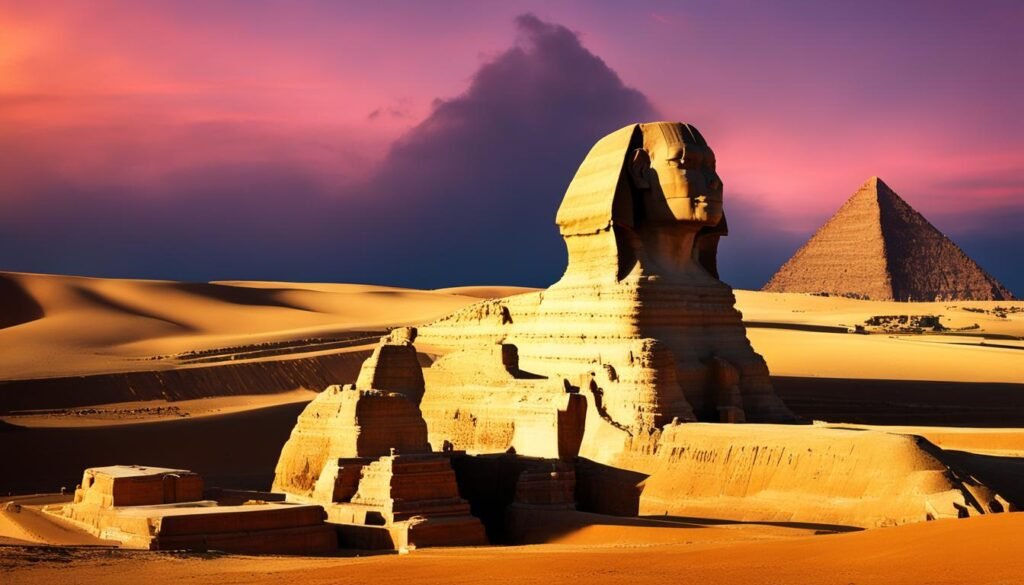
Unveiling the Enigma
“The Great Sphinx of Giza stands as a timeless enigma, captivating the hearts and minds of visitors from around the world. Its majestic presence and intriguing symbolism continue to inspire awe and wonder, inviting us to delve deeper into the mysteries of ancient history.”
– Egyptologist Dr. Zahra Al-Masri
The Great Pyramids
The Great Pyramids of Giza, situated on the outskirts of Cairo, Egypt, are among the most iconic and awe-inspiring ancient structures in the world. These monumental pyramids were constructed as elaborate burial complexes for pharaohs during the Old Kingdom of Egypt. Built over 4,500 years ago, the pyramids were designed to house the pharaohs’ mortal remains and the cherished possessions they believed they would need in the afterlife.
Each pyramid is part of a larger complex that includes temples, smaller pyramids, boat pits, and settlements. The elaborate construction techniques and precision used in building these pyramids have fascinated historians and archaeologists for centuries.
Fun Fact: The Great Pyramids were the tallest man-made structures for over 3,800 years until the construction of the Eiffel Tower in 1889.
“The Great Pyramids of Giza are not merely impressive structures; they are time capsules that give us a glimpse into the beliefs, achievements, and culture of the ancient Egyptians.”
Exploring the complex of the Great Pyramids is an unforgettable experience. Visitors can enter the pyramids, though access may be limited to certain chambers. The Great Pyramid of Khufu, the largest of the three pyramids, offers the most accessible experience, with an interior ascending passage leading to the King’s Chamber.
| Pyramid | Pharaoh | Height (ft) |
|---|---|---|
| The Great Pyramid of Khufu | Pharaoh Khufu (Cheops) | 481 |
| The Pyramid of Khafre | Pharaoh Khafre | 446.5 |
| The Pyramid of Menkaure | Pharaoh Menkaure | 213 |
The Great Pyramids are a testament to the engineering prowess and the religious and cultural beliefs of ancient Egypt. Visiting these monumental structures allows travelers to immerse themselves in the fascinating world of ancient history while marveling at the architectural marvels that have stood the test of time.

The Acropolis of Athens
The Acropolis of Athens is a remarkable testament to the architectural achievements of Greece’s Golden Age. This ancient citadel perched atop a rocky hill in Athens is a must-visit destination for history enthusiasts. With its iconic structures and rich historical significance, the Acropolis offers a glimpse into the grandeur of ancient Greece.
“The Acropolis is not just a collection of ruins; it is an embodiment of the values, culture, and achievements of the ancient Greeks.” – Dr. Maria Petridou, Archaeologist
The Acropolis complex comprises several notable structures, each with its own unique architectural style and purpose. The most famous of these is the Parthenon, an imposing temple dedicated to the goddess Athena. Its intricate marble columns and intricate sculptures make it one of the most iconic landmarks in the world.
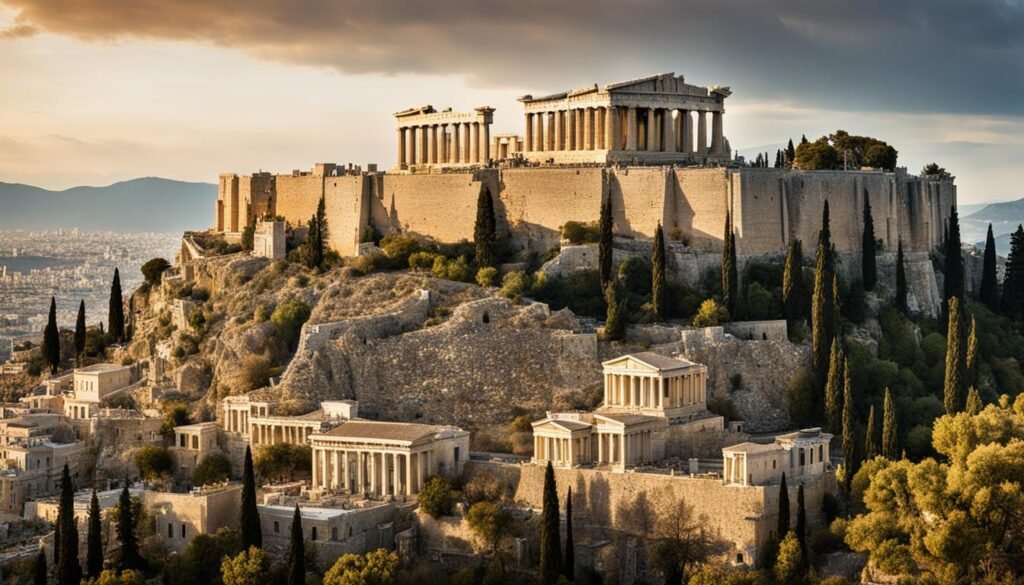
The Propylaia, the monumental gateway to the Acropolis, welcomes visitors with its impressive Doric columns. The Erechtheum, a temple dedicated to multiple gods, features the iconic Porch of the Caryatids, with six female statues as supporting columns.
The Theater of Dionysus, one of the oldest theaters in the world, held significant cultural and religious importance. It hosted theatrical performances and religious festivals dedicated to Dionysus, the Greek god of wine and drama.
The Temple of Athena Nike, situated at the southwest corner of the Acropolis, is known for its intricate frieze depicting mythological scenes. Its elegant proportions and finely carved reliefs demonstrate the artistic prowess of ancient Greek craftsmen.
The Construction of the Acropolis
The construction of the Acropolis spanned from the 6th to the 4th century BCE, with different structures being added over time. Pericles, the prominent Athenian statesman, initiated the ambitious rebuilding and expansion program that transformed the Acropolis into the architectural marvel we see today.
| Structure | Construction Period |
|---|---|
| Parthenon | 447-438 BCE |
| Propylaia | 437-432 BCE |
| Erechtheum | 421-406 BCE |
| Theater of Dionysus | 5th century BCE |
| Temple of Athena Nike | 427-424 BCE |
The Acropolis, with its timeless beauty and historical significance, has earned its place as a UNESCO World Heritage Site. History enthusiasts from around the world flock to Athens to witness this marvel of ancient Greek civilization.
If you’re planning a trip to Greece, make sure to include the Acropolis of Athens in your itinerary. Immerse yourself in the rich history and awe-inspiring architecture that awaits you at this top historical destination.
Petra
Petra, known as the Rose City, is a mesmerizing archeological site located in Jordan. This ancient city was carved into pink sandstone cliffs, creating a stunning and unique architectural marvel. With its rich history and captivating beauty, Petra attracts visitors from around the world who are eager to explore its ancient wonders.
During its heyday, Petra thrived as a trading center, strategically located at the crossroads of important ancient trade routes. It was also a significant part of the Roman Empire, adding to its historical significance. Today, Petra stands as a testament to the ingenuity and artistry of the civilizations that once called it home.
One of the most iconic features of Petra is the Treasury, also known as Al-Khazneh. This elaborate temple is carved into the cliffside and features a stunning Greek-style facade. The Treasury is a testament to the architectural brilliance of the ancient Nabateans, who constructed this majestic structure.
Another highlight of Petra is the collection of royal tombs carved into the cliffs. These intricately designed tombs served as the final resting place for Petra’s elite, showcasing the wealth and power of the city.
Lost to the world for centuries, Petra was rediscovered by Swiss explorer Johann Ludwig Burckhardt in 1812. Since then, it has become a popular destination for archeological sites tourism and ancient history exploration. Visitors can now wander through the narrow, winding Siq (canyon) and discover the awe-inspiring beauty of Petra firsthand.
Visiting Petra is a once-in-a-lifetime experience that allows travelers to step back in time and immerse themselves in the ancient world. It is an archeological wonder that leaves visitors in awe of the incredible accomplishments of past civilizations.
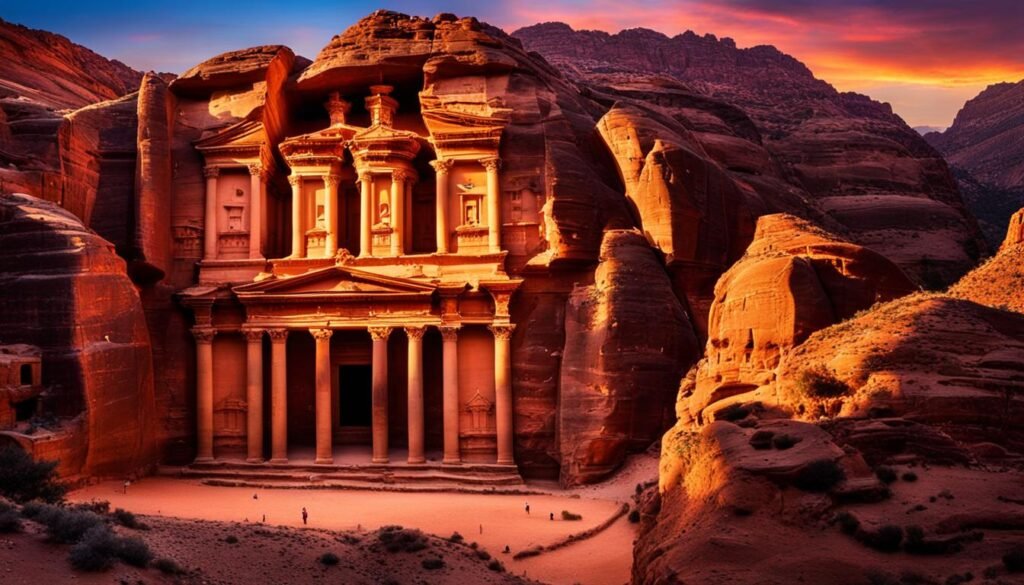
Key Features of Petra:
- The stunning Treasury, an elaborate temple with a Greek-style facade
- Royal tombs carved into cliffs, showcasing the wealth and power of Petra
- The narrow, winding Siq (canyon) that leads to the heart of the city
- Various ancient structures and ruins that offer insight into the daily life of the ancient Nabateans
- The vibrant colors of the rock formations, especially noticeable during sunrise and sunset
The Colosseum
The Colosseum in Rome is an iconic historical site that attracts history enthusiasts from around the world. This magnificent amphitheater, also known as the Flavian Amphitheatre, was a center for entertainment during ancient Roman times.
The Colosseum hosted various spectacles, including gladiator fights, mock naval battles, and theatrical performances. Its grand architecture and capacity to hold up to 50,000 spectators made it one of the most impressive structures of its time.
Despite facing centuries of wear and tear, the Colosseum remains one of the top historical destinations to visit in Rome. Its enduring presence serves as a testament to the rich history of the Eternal City.
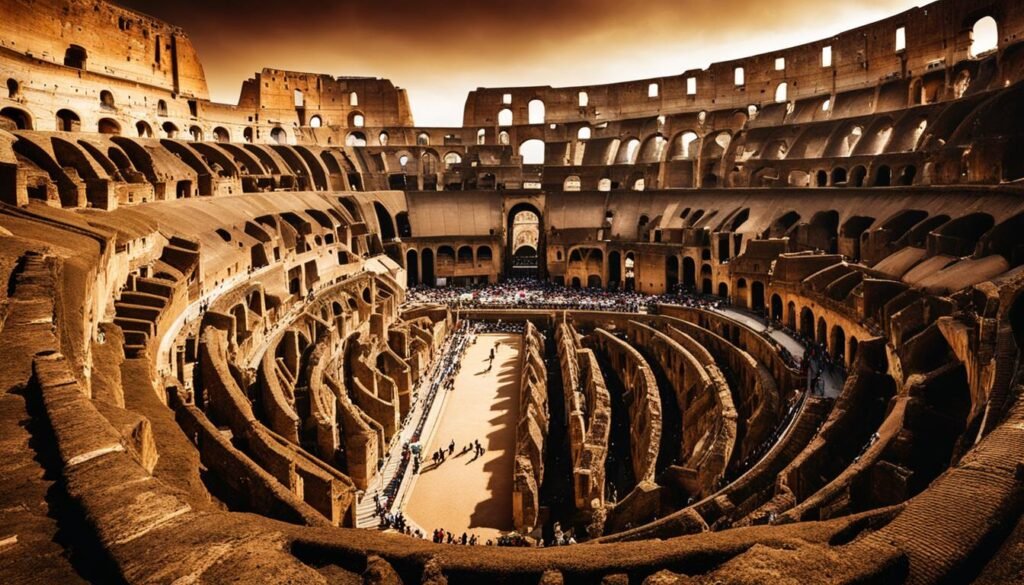
Visitors can explore the different levels of the Colosseum, including the underground chambers where gladiators and animals were held before their performances. Walking through the ancient corridors and imagining the thrilling events that took place within these walls is a truly immersive experience.
“The Colosseum is not only a historical landmark, but it also represents the grandeur and cultural significance of ancient Rome. It is a must-visit destination for all history enthusiasts.”
As you explore the Colosseum, don’t forget to admire the intricate details of its architecture, including the arched entrances, the seating arrangement, and the elaborate network of tunnels and corridors. The Colossus of Nero, a colossal statue that once stood nearby, is another fascinating sight to behold.
To fully appreciate the historical and cultural significance of the Colosseum, consider taking a guided tour or attending one of the many educational presentations offered on-site. These opportunities allow you to delve deeper into the rich history of this remarkable amphitheater.
Colosseum Fast Facts
| Location | Rome, Italy |
|---|---|
| Construction Period | 70-80 AD |
| Architectural Style | Roman |
| Capacity | 50,000 spectators |
| Historical Significance |
|
Visiting the Colosseum allows you to step back in time and witness the grandeur of ancient Rome. Whether you’re a history enthusiast or simply curious about the world’s historical wonders, the Colosseum is a must-visit destination that will leave you in awe.
Angkor
Angkor, located in Cambodia, was once a massive Hindu-Buddhist megalopolis and is now one of the most significant archaeological sites in the world. This ancient city was the largest preindustrial settlement ever built, spanning over 400 square kilometers.
Angkor’s remarkable hydraulic system, including canals, reservoirs, and intricate irrigation networks, allowed the city to thrive and support its vast population. The engineering achievements of the Angkor civilization were truly remarkable and demonstrate their advanced understanding of urban planning and water management.
The site is home to dozens of awe-inspiring temples and monuments, each showcasing intricate architectural details and rich cultural significance. Among them, the iconic Angkor Wat stands as a testament to the grandeur and devotion of the Khmer Empire. With its towering spires and intricate bas-reliefs, Angkor Wat is considered one of the most magnificent religious buildings ever constructed.
As a UNESCO World Heritage Site, Angkor attracts visitors from around the globe who seek to explore the remnants of this ancient civilization. From the stunning temple complexes to the peaceful surrounding landscapes, Angkor offers a unique and immersive experience for those fascinated by ancient civilizations and the mysteries of the past.
“Angkor represents an extraordinary cultural, religious, and symbolic complex that played a crucial role in the history of southeast Asia. It stands as a testament to the artistic and architectural brilliance of the Khmer Empire.” – UNESCO
Exploring Angkor is a must for any traveler interested in ancient civilizations. Immerse yourself in the rich history, marvel at the intricate architecture, and discover the stories engraved in every stone. Whether you are a history enthusiast or simply seeking a unique and awe-inspiring travel experience, Angkor should be at the top of your list of must-visit archaeological sites.

| Feature | Description |
|---|---|
| Angkor Wat | The largest religious monument in the world, known for its intricate carvings, massive towers, and stunning bas-reliefs. |
| Bayon Temple | Famous for its numerous stone faces, this temple is a masterpiece of Khmer architecture. |
| Angkor Thom | An ancient walled city featuring monumental gates, terraces, and the impressive Baphuon temple. |
| Ta Prohm | Known as the “Tomb Raider” temple, this site showcases the harmony between nature and ancient architecture. |
| Preah Khan | A magnificent temple complex with elaborate carvings and well-preserved structures. |
Conclusion
When it comes to ancient history and archaeological sites, these top destinations offer an unparalleled exploration of past civilizations. From the enigmatic Stonehenge in the United Kingdom to the majestic Great Wall of China, each site carries immense historical and cultural significance.
Embarking on ancient history vacations and archeological sites tourism allows you to immerse yourself in the wonders of these top historical destinations. You can witness the architectural feats of ancient civilizations and marvel at the ingenuity of their engineering and artistic achievements.
Whether you are fascinated by the mysterious ruins of Chichén Itzá or intrigued by the Great Sphinx of Giza in Egypt, these must-visit archaeological sites will leave you in awe. Historical ruins tours offer a unique chance to unravel the stories of the past and gain a deeper understanding of our shared human heritage.
For true history enthusiasts and avid travelers, the exploration of ancient history is an enriching experience. Discover the ancient wonders, delve into the depths of the past, and create unforgettable memories as you embark on a journey to these remarkable archaeological sites.
FAQ
What is Stonehenge?
Stonehenge is a prehistoric archaeological site in the United Kingdom. It consists of massive prehistoric stones arranged in a circle and is believed to have been built by Neolithic and Bronze Age people. It may have served as a burial ground or a site of ritual sacrifice. Stonehenge is a UNESCO World Heritage Site.
What is the Great Wall of China?
The Great Wall of China was built by Emperor Qin Shi Huang and was intended to prevent intrusions by nomadic tribes. It is the world’s largest military structure, spanning over 13,000 miles. The wall is made of earth and stone and features guard towers. It is a UNESCO World Heritage Site.
What is Chichén Itzá?
Chichén Itzá was a thriving Mayan city in Mexico. Its notable feature is the step pyramid called El Castillo, which is dedicated to the god Kukulkán. The pyramid casts a shadow that resembles a moving serpent during the equinoxes. Chichén Itzá is a UNESCO World Heritage Site.
What is the Great Sphinx of Giza?
The Great Sphinx of Giza is a limestone statue in Egypt. It is believed to have been built during the reign of Pharaoh Khafre and serves as a guardian for his pyramid tomb. The Sphinx has the head of a human and the body of a lion. It is the largest monolithic statue in the world.
What are the Great Pyramids of Giza?
The Great Pyramids of Giza are elaborate burial complexes built by pharaohs. These pyramids housed the goods that the pharaohs believed they would need in their next life. Each pyramid is part of a larger complex that includes temples, pits containing parts of a wooden boat, and smaller temples and settlements.
What is the Acropolis of Athens?
The Acropolis of Athens is a significant architectural achievement of Greece’s Golden Age. It includes the iconic Parthenon, the Propylaia, the Erechtheum, the Theater of Dionysus, and the Temple of Athena Nike. The Acropolis underwent construction periods from the 6th to the 4th century BCE and is a UNESCO World Heritage Site.
What is Petra?
Petra, known as the Rose City, was an ancient city carved into pink sandstone in Jordan. It thrived as a trading center and was part of the Roman Empire. The city features the Treasury, a temple with a Greek-style facade, and royal tombs carved into cliffs. Petra was lost for centuries before being rediscovered.
What is the Colosseum?
The Colosseum in Rome was an amphitheater used for various forms of entertainment, including gladiator fights. It is the largest standing amphitheater in the world and serves as a symbol of the Eternal City. The Colosseum has suffered damage over the years but remains a popular tourist attraction.
What is Angkor?
Angkor was a massive Hindu-Buddhist megalopolis in Cambodia. It was the largest preindustrial settlement in the world. Angkor’s hydraulic system, including canals and reservoirs, allowed the city to thrive. The site features dozens of monuments and temples, including the iconic Angkor Wat. It is a UNESCO World Heritage Site.

